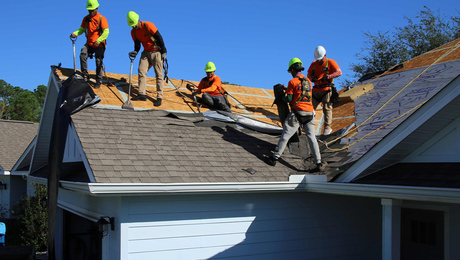*
Sorry to ruin what is a beautiful day here in Indianapolis (and where ever you may be) with the topic of vapor barriers, but, …. I am having a house built (it’s my first) and the contractor used a combination of unfaced fiberglass insulation and kraft faced insulation in the rooms where there are 9 foot ceilings. The top foot of the walls is kraft faced insulation. Then, as a vapor barrier, only the unfaced insulation was covered with poly. The poly overlaps the kraft by a couple of inches. After searching the archives, I think I understand what should be done, but I am asking you for your input on this topic. Should I request (insist) that the wall be covered 100 percent with poly or is the insulation subcontractor correct in saying that the kraft is an adequate vapor barrier.
Thanks, ScottZ
Discussion Forum
Discussion Forum
Up Next
Video Shorts
Featured Story

Listeners write in about haunted pipes and building-science tomes, and they ask questions about roof venting and roof leaks.
Featured Video
SawStop's Portable Tablesaw is Bigger and Better Than BeforeHighlights
"I have learned so much thanks to the searchable articles on the FHB website. I can confidently say that I expect to be a life-long subscriber." - M.K.














Replies
*
Really? You read the archives and now think you know what should be done? I'd love to hear what you understood from the archives. Speaking strictly as a reader of the board, with no first hand experience, I would guess the most you would need is to tape the joint between the kraft and the poly. It's either that or you should slash the poly because the vapor barrier is bad.
What is the complete wall, inside to out?
Your probably not getting any traffic here because people are burned out on the subject.
Rich Beckman
*Well i'll stick my neck out and say that if you desire a vapor barrier then, the poly should cover top and bottom plates without seams that aren't lapped on studs. In my humble opinion the poly up to the little piece of kraft face is a cockamainy idea. joe d
*The kraft face should be slasheed with a utility knife, and the whole thing covered with poly. The kraft face wont do a complete job of keeping the moisture out of your walls. There were some posts on this last week.
*Look at the discussion on the construction techniques bulletin board.
*
Thanks to all who responded to my question. I posted this question just before I saw the other thread in the Construction Techniques. The insulation subcontractor has replaced the kraft faced insulation with unfaced insulation and covered the wall with poly. When I originally walked into the house and saw the two types of insulation I had a feeling that something was not quite right. Since I am a home owner and not a builder or insulation expert, I don't have the background to know whether this was normal practice. So I then went into another house being built in the same neighborhood, same builder, same basic floorplan, same insulation subcontractor and saw the insulation was done differently. No kraft backed insulation was used in that house. Why? Who knows. Did it raise a question? Yes. Doing things right is important. Doing thing consistently is also important. It raises less questions and IMO a home owners peace of should be worth something to the builder. Thanks again. Scott
*
Sorry to ruin what is a beautiful day here in Indianapolis (and where ever you may be) with the topic of vapor barriers, but, .... I am having a house built (it's my first) and the contractor used a combination of unfaced fiberglass insulation and kraft faced insulation in the rooms where there are 9 foot ceilings. The top foot of the walls is kraft faced insulation. Then, as a vapor barrier, only the unfaced insulation was covered with poly. The poly overlaps the kraft by a couple of inches. After searching the archives, I think I understand what should be done, but I am asking you for your input on this topic. Should I request (insist) that the wall be covered 100 percent with poly or is the insulation subcontractor correct in saying that the kraft is an adequate vapor barrier.
Thanks, ScottZ
*
Sounds like someone had a few extra rolls to burn up, pocket change.